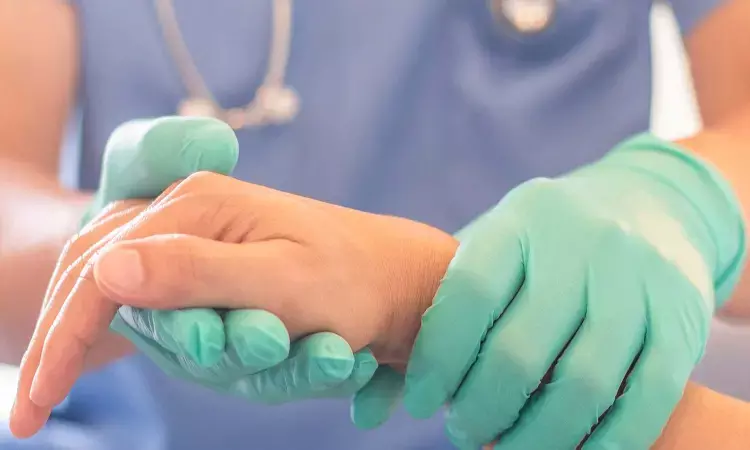- Home
- Medical news & Guidelines
- Anesthesiology
- Cardiology and CTVS
- Critical Care
- Dentistry
- Dermatology
- Diabetes and Endocrinology
- ENT
- Gastroenterology
- Medicine
- Nephrology
- Neurology
- Obstretics-Gynaecology
- Oncology
- Ophthalmology
- Orthopaedics
- Pediatrics-Neonatology
- Psychiatry
- Pulmonology
- Radiology
- Surgery
- Urology
- Laboratory Medicine
- Diet
- Nursing
- Paramedical
- Physiotherapy
- Health news
- Fact Check
- Bone Health Fact Check
- Brain Health Fact Check
- Cancer Related Fact Check
- Child Care Fact Check
- Dental and oral health fact check
- Diabetes and metabolic health fact check
- Diet and Nutrition Fact Check
- Eye and ENT Care Fact Check
- Fitness fact check
- Gut health fact check
- Heart health fact check
- Kidney health fact check
- Medical education fact check
- Men's health fact check
- Respiratory fact check
- Skin and hair care fact check
- Vaccine and Immunization fact check
- Women's health fact check
- AYUSH
- State News
- Andaman and Nicobar Islands
- Andhra Pradesh
- Arunachal Pradesh
- Assam
- Bihar
- Chandigarh
- Chattisgarh
- Dadra and Nagar Haveli
- Daman and Diu
- Delhi
- Goa
- Gujarat
- Haryana
- Himachal Pradesh
- Jammu & Kashmir
- Jharkhand
- Karnataka
- Kerala
- Ladakh
- Lakshadweep
- Madhya Pradesh
- Maharashtra
- Manipur
- Meghalaya
- Mizoram
- Nagaland
- Odisha
- Puducherry
- Punjab
- Rajasthan
- Sikkim
- Tamil Nadu
- Telangana
- Tripura
- Uttar Pradesh
- Uttrakhand
- West Bengal
- Medical Education
- Industry
Electromagnetic sensor system may help assess distal radioulnar joint movement

The accurate assessment of distal radioulnar joint (DRUJ) instability is still challenging as there is no established objective evaluation method. A new measurement method using EMS could evaluate DRUJ movement with high accuracy, reproducibility, and intra- and inter-rater reliability, reveals a study.
The study is published in the Journal of Orthopaedic Surgery and Research.
Shintaro Mukohara and associates from the Department of Orthopaedic Surgery, Kobe University Graduate School of Medicine, Kobe, Japan carried out the present study to develop a noninvasive measurement method using a three-dimensional electromagnetic sensor system (EMS) to quantitatively assess and characterize the normal DRUJ movement in healthy volunteers.
The DRUJ movement was mimicked using both a block model and saw bone. Movement of the models was measured by EMS, and the accuracy and reproducibility of the measurements were assessed. In vivo measurement was performed in a sitting position with the elbow flexed and the forearm pronated.
One sensor each was attached to the distal radial shaft and the ulnar head. The examiners fixed the distal radius and the carpal bones, moved the ulnar head from the dorsal to the volar side and measured the dorsovolar translation.
The volar translation was measured by EMS and ultrasonography, and the correlation coefficient was calculated. The dorsovolar translation was evaluated in 14 healthy volunteers (7 men and 7 women) by three hand surgeons. The intraclass and inter-rater correlation coefficients (ICCs), the differences between the dominant and non-dominant sides and between men and women were assessed.
The results showed that the accuracy and reproducibility assessment results of the EMS showed high accuracy and reproducibility. In the comparison between EMS and ultrasonography, the correlation coefficient was 0.920.
The ICC (1,5) for the intra-rater reliability was 0.856, and the ICC (2,5) for inter-rater reliability was 0.868. The mean ulnar head translation and difference between dominant and non-dominant sides were 6.00 ± 1.16 mm (mean ± SD) and − 0.12 ± 0.40 mm, respectively.
Hence, there were no significant differences between any of the parameters.
Therefore, the authors concluded that "a new measurement method using EMS could evaluate DRUJ movement with high accuracy, reproducibility, and intra- and inter-rater reliability. In healthy volunteers, the dorsovolar ulnar head translation was 6.00 mm. The difference between the dominant and non-dominant sides was < 1.0 mm with no significant difference. EMS provided an objective, non-invasive, real-time assessment of dynamic changes in the DRUJ. These findings could be useful in the treatment of patients with DRUJ instability."
Dr. Nandita Mohan is a practicing pediatric dentist with more than 5 years of clinical work experience. Along with this, she is equally interested in keeping herself up to date about the latest developments in the field of medicine and dentistry which is the driving force for her to be in association with Medical Dialogues. She also has her name attached with many publications; both national and international. She has pursued her BDS from Rajiv Gandhi University of Health Sciences, Bangalore and later went to enter her dream specialty (MDS) in the Department of Pedodontics and Preventive Dentistry from Pt. B.D. Sharma University of Health Sciences. Through all the years of experience, her core interest in learning something new has never stopped. She can be contacted at editorial@medicaldialogues.in. Contact no. 011-43720751
Dr Kamal Kant Kohli-MBBS, DTCD- a chest specialist with more than 30 years of practice and a flair for writing clinical articles, Dr Kamal Kant Kohli joined Medical Dialogues as a Chief Editor of Medical News. Besides writing articles, as an editor, he proofreads and verifies all the medical content published on Medical Dialogues including those coming from journals, studies,medical conferences,guidelines etc. Email: drkohli@medicaldialogues.in. Contact no. 011-43720751


